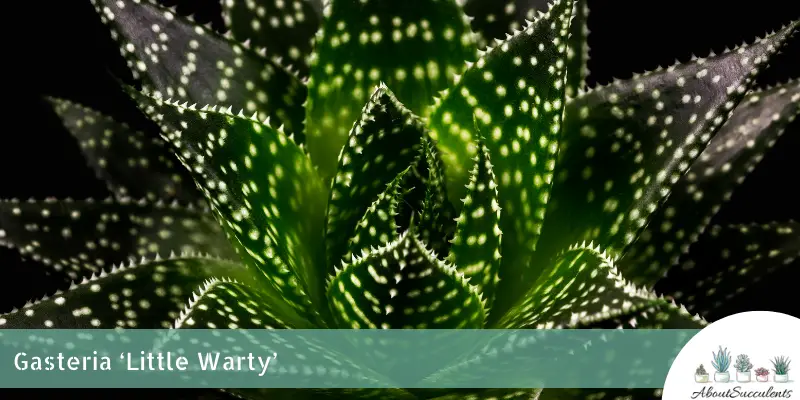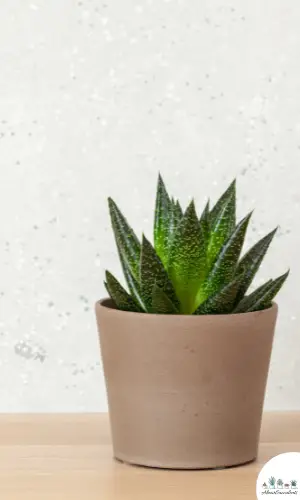
Gasteria ‘Little Warty’ also known as Ox Tongue is a slow-growing perennial succulent with stemless rosettes. It grows up to 20cm (8”) tall and up to 15cm (6”) wide.
Little Warty has long, pointed dark green leaves with silvery-lime green mottled highlights and edges. These thick leaves have plenty of white pearly bumps that resemble warts.
What makes this small succulent unique is its shiny hard plastic appearance. The leaves grow in even numbers, arranged in a distal or rosette manner.
In spring, Gasteria ‘Little Warty’ blooms racemes of pink-green tubular flowers on a stem that grows above the foliage.
Gasteria ‘Little Warty’ is a cross between Gasteria batesiana and Gasteria ‘Old Man Silver’, acquired by the Australian hybridizer David Cumming. It is a part of the Gasteria genus from the Asphodelaceae family and is native to South Africa.
General Information:
Also known as: Ox Tongue
Plant family: Asphodelaceae
Origin: South Africa
Height: 20cm (8”)
Exposure: Partial to full morning sun for 5 to 6 hours per day.
Water Needs: Drought-resistant, use the ‘soak and dry’ method of watering.
Soil Type: Succulent potting soil combined with pumice, perlite, coco coir, pine bark, and sand.
Soil pH: 6 to 7
How to Grow Gasteria ‘Little Warty’
Gasteria ‘Little Warty’ is a low-maintenance plant that can survive many years in your indoor shallow container garden or outdoor rock garden.
The Ox Tongue is not cold-hardy and cannot survive temperatures below -1.1° C (30° F). If your region experiences temperatures below these levels, it would be best to plant Little Warty in a movable container.
Sunlight
Gasteria ‘Little Warty’ loves bright sunlight. If you will plant it outdoors, choose a location where it can be exposed to partial to full morning sun for 5 to 6 hours a day.
Avoid direct exposure to sunlight to prevent sunburn. If planting indoors, place it in a southern-facing or west-facing window to ensure adequate exposure to bright light. 5 to 6 hours of exposure to partial sun will help your indoor plant grow well.
Low light conditions will result in etiolation, where leaves elongate to seek sunlight. The leaves will end up withered and severely weakened.
Watering

The best way to water your Gasteria ‘Little Warty’ is to soak the soil thoroughly then allow it to dry out completely before watering again. If planted indoors, make sure to water the soil only because the leaves can rot if the water sits on them for too long.
The ‘soak and dry’ method of watering will help your Gasteria ‘Little Warty’ develop strong drought-resistant roots.
Overwatering causes roots to rot so make sure to keep track of your watering schedule. Test the soil’s dryness before watering by inserting your finger 2” deep into the soil.
In summer, you need to water your succulent more frequently because the soil dries out faster during this time. In winter, you can water less because the soil stays damp longer.
Pot and Soil
Use a terracotta or ceramic pot with drainage holes. This type of container allows moisture to evaporate faster. The holes in the bottom of the pot allow excess water to flow out faster and air to flow through the soil. The Ox Tongue has shallow roots so it will grow better in a shallow and wide pot.
Gasteria ‘Little Warty’ needs to be planted in well-draining soil. You can buy a succulent mix or you can prepare your own potting mix. Combine equal portions of potting soil and gritty materials such as pumice, perlite, coco coir, pine bark, and sand.
Add a liquid natural fertilizer once every spring to enhance soil health.
How to Propagate Gasteria – Little Warty
Gasteria ‘Little Warty’ can be propagated by using leaves cuttings or repotting offsets in spring or summer.
Method 1: Offsets
Step 1: Choose healthy offsets around the base of the plant.
Step 2: Gently pull out the offsets from the soil or use a sharp sterile knife to cut as close to the base with as many roots attached to the offsets.
Step 3: Allow the offsets to dry in a warm area for a few hours before repotting.
Step 4: Get a terracotta pot with drainage holes and fill it with potting soil mixed with organic and inorganic grit.
Step 5: Plant your offsets. Lightly water the soil and place the pots in a bright area.
Method 2: Leaves Cuttings
Step 1: Use a sharp sterile knife or scissors to cut healthy leaves.
Step 2: Leave the cuttings in a dry area for a few days until the basal tissues have sealed and calloused over.
Step 3: Lay the cuttings on their sides with the base buried in potting soil mixed with gritty materials.
Step 4: Place the container in a warm, bright area preferably near a window. Spray the topsoil every day.
Frequently Asked Questions
Is Gasteria ‘Little Warty’ Toxic to Cats and Dogs?
No, Gasteria ‘Little Warty’ is not included in the list of plants that are toxic to cats and dogs on the website of the American Society for the Prevention of Cruelty to Animals (ASPCA).
Why is My Gasteria ‘Little Warty’ Dying?
If your Gasteria ‘Little Warty’ appears unhealthy, it could be caused by 2 factors: Overwatering and pest infestation.
Overwatering
Letting your succulent sit in water for too long will lead to root rot. Overwatered soil prevents roots from absorbing the oxygen they need.
Save your overwatered Gasteria ‘Little Warty’ by removing the diseased parts immediately.
Gently remove your plant from the soil. Shake off excess soil and carefully examine the roots. Use a sharp sterile knife or shears to cut the rotten roots.
Leave the plant on a strainer or mesh and allow the roots to dry out for two to three days. Replant your Gasteria ‘Little Warty’ in a terracotta pot filled with fresh potting mix. Water it properly.
Pest Infestation
Gasteria ‘Little Warty’ is prone to mealybugs and aphids infestation. As soon as you detect signs of pest infestation, give your plant immediate treatment.
Remove mealybugs by directly applying a q-tip dipped in rubbing alcohol on them. You can also spray the plant with alcohol or diluted dishwashing soap. Repeat the treatment once a week until you rid the plant of mealybugs.
Aphids can be removed by spraying your plant with soapy water or neem oil once a week until you get rid of the infestation. Dilute 1 tbsp of neem oil in 8 cups of water and mix well. When using neem oil, spray your plant in the late afternoon to prevent sun damage.
Does Gasteria ‘Little Warty’ Produce Flowers?
Yes, Gasteria ‘Little Warty’ blooms pink-green tubular flowers in spring.
Last Updated on June 9, 2022 by Sofia Lara